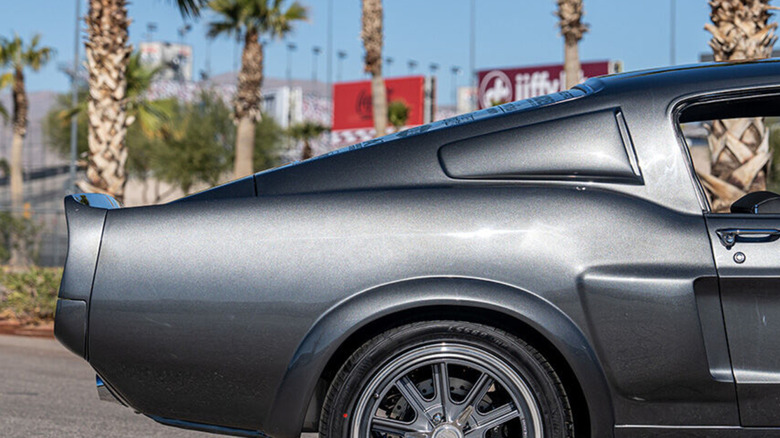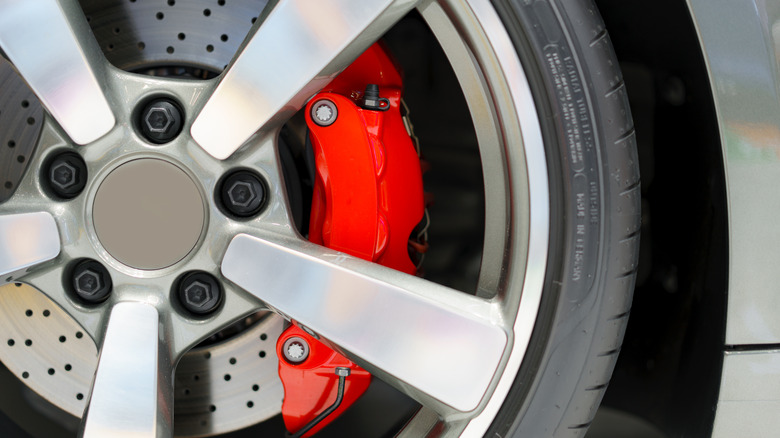What Makes A Tire 'Ultra High Performance'?
Ultra high performance tires, or UHP tires, have been developed in response to ever-faster and more powerful cars. These UHP tires do more than just deliver improved grip, they also help to reduce stopping times and improve heat dissipation. Furthermore, switching from standard to UHP tires delivers the expected traction and cornering benefits you'd likely assume a performance tire would provide.
Typically, UHP tires are what's also known as low profile tires, which differ from standard tires. Tires with lower side profiles were developed to accommodate larger alloy wheels, which take up more wheel-well space than smaller wheels. While large wheels may seem like a purely cosmetic choice — and in some cases, they are — they also allow for the fitment of larger, more powerful brakes. In order to sneak large brakes and therefore large wheels into the wheel-well, low-profile tires are required. Circling back to UHP tires, vehicles with large wheels and brakes tend to be performance-orientated. This inevitably leads to many UHP tires also sporting lower profiles.
Generally, we associate high-performance cars with sleek coupes and sports sedans, but in today's day and age even larger vehicles like SUVs can warrant UHP tires. That's why brands such as Landsail have developed a wide range of UHP tires, with SUV-specific options that sport a stronger structure which can support the additional heft of larger vehicles.
Ultra high performance tires can withstand higher top speeds
Sports and performance cars don't just need improved grip through the corners, either; they also need to sport tires capable of withstanding higher top speeds. This is why ultra high performance tires will typically carry a speed index of W or Y, indicating they are capable of such speeds. Speed indexes are how you can work out the top speed rating of a tire. For example, a tire with a W speed index is capable of safely hitting 168 mph, whereas a tire rated with a Y speed index can crack 186 mph — that's the top speed of an Aston Martin DB9, for reference.
It's one thing to develop a tire that can withstand high speeds, but developing a tire which is also stable at such speeds is another thing altogether. This is why UHP tires look to prioritize large contact areas between the tread and the road. Not only does a large and connected tread pattern such as this benefit stability at speed, but it also allows for better control when cornering at speed, making UHP tires a great all-rounder for performance vehicles. While enthusiastic driving like this is usually associated with fair weather conditions, added sipes and grooves into the tread pattern of UHP tires also enables the tire to perform better in adverse conditions. This means UHP tires can safely be used all year round, too.
Ultra high performance tires are not a budget option
As with most things associated with performance cars, UHP tires do not come cheap – at least not in comparison to standard road tires. This doesn't mean that affordable options aren't out there though, as evidenced by the Landsail LS588 UHP, which can be picked up online for as little as $73.99. So while prices do vary by tire size, UHP tires don't necessarily have to be the most expensive tires in the world. Other tires from Landsail, such as the LS388 – a summer performance tire — do come in at over $20 cheaper per corner though, so UHP tires definitely do carry a noticeable premium.
Buyers may be tempted to save money and fit standard road tires to their car instead of UHP options, but if you drive a performance vehicle and plan on taking advantage of that extra power, it would be wise to stick with UHP tires. The extra cornering and top speed capability of the tire means performance vehicles can be enjoyed with peace of mind, which is easily worth the extra dollars commanded by UHP tires.


